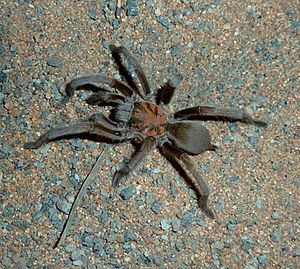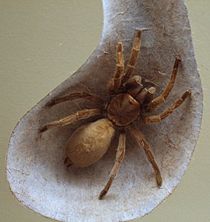Barking spider facts for kids
Quick facts for kids Barking spider |
|
|---|---|
 |
|
| Scientific classification |
Selenocosmia stirlingi is a species of tarantula (family Theraphosidae) that is native to the arid regions of Australia. It is sometimes also referred to as a barking spider or whistling spider as this species, like many tarantulas, can stridulate to produce a "hissing" sound when disturbed or threatened. This species is largely fossorial, living in burrows deep underground, however males are sometimes encountered during the breeding season.
Taxonomy and naming
This species was originally described by Henry R Hogg in 1901. However, early research from 1894 had noted that this species could produce an audible sound. This is likely how the species got the name "the barking spider". Selenocosmia stirlingi is a member of the Selenocosmiinae subfamily, which is widespread throughout Australia and South-East Asia.
Habitat

Barking spiders live in the Australian desert and are ambush predators from burrows placed among leaf litter.
Prey
Barking spiders wait in their burrows for insects, lizards or frogs to come near the entrance before grasping and injecting venom into them. Their venom has not been found to be medically significant to humans.
Predators
As it is a small animal, the barking spider has quite a lot of predators even in the desert. Some of these include owls, dingoes and feral cats.
Adaptations
The barking spider depends on special adaptations to survive in its natural habitat. They have a gill-like lung that requires humidity and strong claws that enables them to dig burrows and stay cool. Barking spiders also have bushy feet with some secreted oil which produces a suction-cup ability, which allows them to easily climb up steep rocks in the desert.
Pet trade
This species as well as several other tarantula species within Australia are sometimes collected and sold as pets. The extent of collecting from the wild has not been well characterised, but illegal collecting and harvesting of wild populations are likely to be detrimental to the species.

